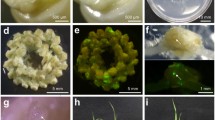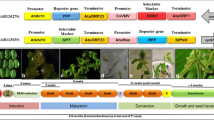Abstract
We have obtained transgenic lily (Lilium longiflorum) plants after microprojectile bombardment, using the Biolistics PDS 1000/He system, of morphogenic calli derived from bulblet scales, followed by bialaphos selection. Parameters which gave the highest transient uidA expression were used: a bombardment pressure of 1100 psi, a target distance of 6 cm and a 48-h preculture on medium with 3% sucrose. A total of 1800 morphogenic calli were co-bombarded with plasmids containing either the uidA reporter or PAT selectable marker genes. After bombardment, the calli were exposed to 2 mg/l bialaphos. Only 72 of the shoot-forming calli (4%) survived. The 72 shoot clusters produced 342 shoots on elongation medium containing 0.5 mg/l bialaphos. Only 55 plantlets survived subsequent exposure to 2.0 mg/l bialaphos. PCR analysis indicated that 19 of these plantlets contained the PAT transgene. Southern analysis of 3 of the plants indicated that all contained the PAT gene.
Similar content being viewed by others
Author information
Authors and Affiliations
Additional information
Received: 21 March 1997 / Revision received: 8 July 1997 / Accepted: 7 August 1997
Rights and permissions
About this article
Cite this article
Watad, A., Yun, DJ., Matsumoto, T. et al. Microprojectile bombardment-mediated transformation of Lilium longiflorum. Plant Cell Reports 17, 262–267 (1998). https://doi.org/10.1007/s002990050389
Issue Date:
DOI: https://doi.org/10.1007/s002990050389




